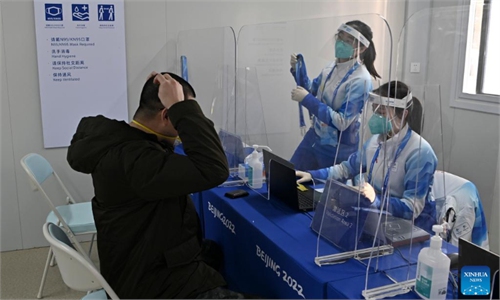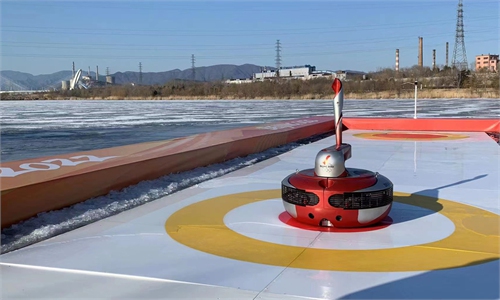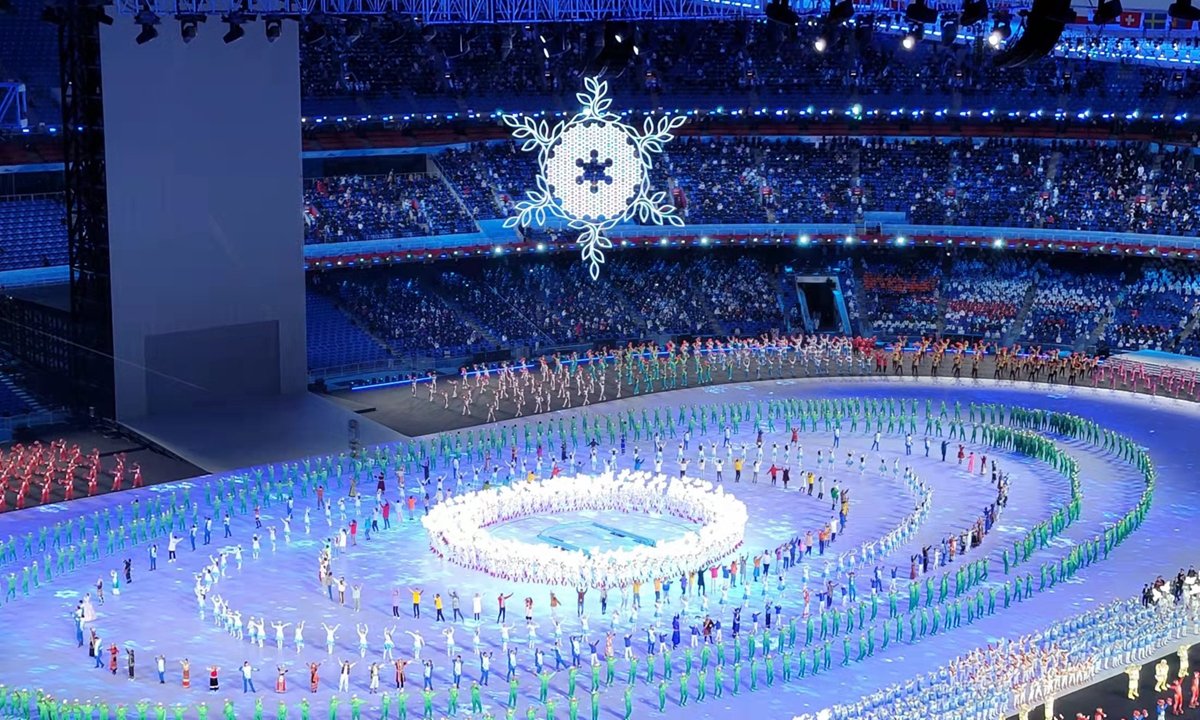
A total of 550,000 LED lamp beads form up the giant snow flake that holds the Olympic flame. Photo: Courtesy of BOE Technology Group Co.,which made the snow flake
From icy floors that micro-manage temperatures inside world-class stadiums to the gigantic cable roof that spans the National Speed Skating Oval, China's unrivaled infrastructure was behind the spectacular and grand Beijing 2022 Winter Olympics, ensuring the games' success but also provided a number of benefits that could ensure more Chinese gain easier access to winter sports.
As the games unfold and athletes snatch medals, the impeccable quality of Olympic stadiums and related infrastructure, the speed with which they were constructed and the scale of these venues did not go unnoticed.
During the past years of preparation, China has been dedicated to fulfilling its commitments after it won the bid, completing the Olympic stadiums often months ahead, which not only showcased its national strength and technological advantages, but also displayed strong contrast with some of the more hasty completion of projects in previous games.
China's world-class infrastructure construction giants, which are famous for building roads and bridges of high quality at competitive costs and connecting the world's trade routes, also lend their weight to the great sports event, bringing their expertise to stadiums and other infrastructure of the Olympics.
"It is just outstanding," Christophe Dubi, executive director of the Olympic Department of the International Olympic Committee (IOC), praised the physical infrastructure that has been around the Olympic venues in an earlier interview with a Chinese media outlet.
Dubi described the Ice Ribbon, the nickname of the National Speed Skating Oval, as "incredible," "takes people's breath away," and has "absolutely formidable visual impressions from outside and inside."
Highest standard
It is worth noting that the construction of the Olympic stadiums also incorporated green concepts with innovative practices and technological breakthroughs, which underlined China's capacity in the field of infrastructure construction.
The National Speed Skating Oval is an example of scientific and technological innovation, demonstrating China's comprehensive capability in building Olympic stadiums from design and technological applications to materials and manufacturing, Yue Peng, chairman of Beijing State-owned Assets Management Company, told the Global Times on Monday. The company operates the National Stadium, the Beijing National Aquatics Center, and the National Speed Skating Oval.
The National Speed Skating Oval realized the world's largest span (at 198 meters) orthogonal two-way saddle-shaped cable-net roof, and mastered the technology of high-vanadium airtight cables - a technology previously new to China, Yue said.
During the Beijing 2022, 39 venues will be utilized. Eight venues from Beijing 2008 Olympics will be reused in 2022.
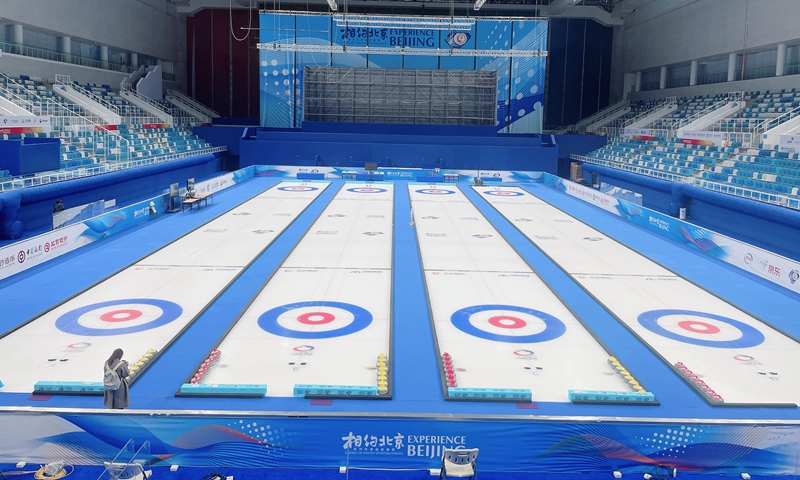
The Beijing Winter Olympics main curling venue, dubbed the "Ice Cube," is reconstructed from a swimming pool. Photo: Cui Fandi/GT
The venues for the Beijing Winter Olympic Games have been equipped with all types of high-tech tools to ensure the global sporting event is held without a hitch. The Ice Cube, for example, a curling arena transformed from the former Beijing Summer Olympic Games' swimming pool, is the first venue in the world to achieve a "water-ice transition."
China State Construction Engineering Corporation (CSCEC), which takes credit for some of the world's most iconic buildings, was involved in 27 Olympic stadiums and auxiliary projects.
The Winter Sports Management Center of General Administration of Sport of China, also known as the Ice Altar, is a giant building with a total construction area of 33,220 square meters and the only winter ice training and competition base for the administration as well as China's first standard curling training ground.
Li Shui, project manager of Ice Altar, told the Global Times on Monday that meeting the stringent Olympic standards requires attention being paid to the minutest detail and building these stadiums proved to be a litmus test of the constructors' skills.
"To accurately manage the temperature of the ice floor (inside the Ice Altar), a total of 13 layers of steel, tar, cement and piping works are neatly woven together. The cement used underneath the ice layer needs to have enough strength to support the upper structure while protecting the refrigeration piping," Li said. "The cement has to withstand 200 melt-freeze cycles of the ice layer above."
In addition, 6,840 welding points were scattered along 47,120 meters of piping, requiring impeccable welding skills - any deformity will cause the entire piping to malfunction, while incomplete welding risks leaks.
First-rate quality
Experts said the first-rate quality of Olympics venues reflects China's growing prowess in infrastructure construction in recent decades. China is home to six of the world's 10 tallest skyscrapers, seven of the world's top 10 ports, and eight of the world's top 10 super bridges.
Nowhere is such an example more conspicuous than the fact that between the time span of two Olympics of 14 years, China has built the world's largest high-speed railway (HSR) network spanning over 40,000 kilometers, with the first leg of HSR put into operation shortly before the Beijing 2008 Summer Olympics. In 2021 alone, a total of 2,168 kilometers of high-speed rails were added to the national network.
Serving the Winter Games, the Beijing-Zhangjiakou High-speed Railway, a state-of-the-art, driverless, 5G livestreaming-enabled HSR line is expected to conduct 200,000 trips for participants including athletes, coaches, media representatives and officials.
The railway, starting operation in December 2019, is the dual birthplace of China's first modern railway and China's first smart technology enabled high-speed railway with a designed speed of 350 kilometers per hour and is in itself a museum to China's development path.
The speed with which these stadiums were built, often completed months ahead of schedule, also reflects China's effective epidemic control policy, an industry insider told the Global Times on Monday on condition of anonymity.
"China's construction industry is one of the least affected compared globally amid the pandemic. The domestic success in containing the virus and China's infrastructure constructors' strict discipline in observing anti-epidemic precautions were the key for the timely completion of these super Olympic projects," the person said.
Contributing to mass sports
IOC President Thomas Bach said on Sunday at an Alibaba cloud hologram event that the Beijing 2022 Winter Olympics will be the start of a new era for global winter sports, and China's extraordinary achievements in winter sports will change the landscape of winter sports around the world forever.
In addition to a long list of global infrastructure champions, the efforts to present a dazzling event in front of the world also enlisted leading Chinese companies in the new digital sphere.
Chinese panel display producer BOE Technology Group, one of the world's largest manufacturers of LCDs, OLEDs and flexible displays, fielded the stage floor of the opening ceremony of the Beijing Winter Olympic Games.
The system is currently the world's largest 8K ultra-high-definition ground display system, with an overall area of 10,393 square meters, according to a statement sent to the Global Times by the company on Monday.
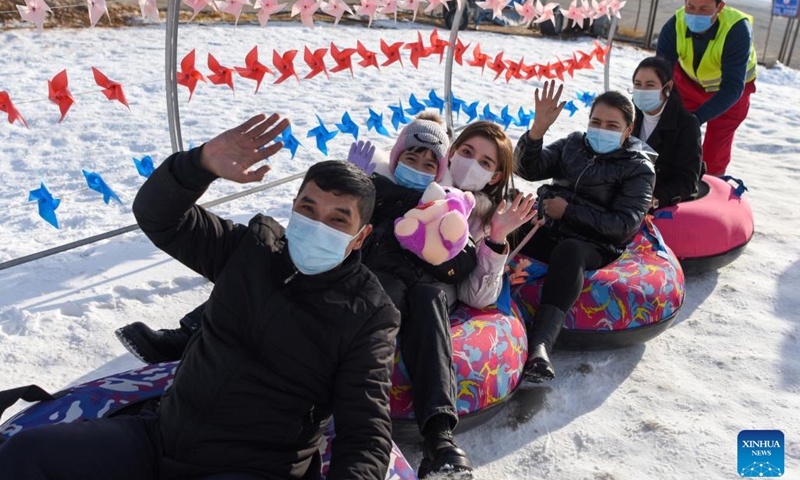
Tourists play on snow tubes at Oynak ski resort in Moyu County, northwest China's Xinjiang Uygur Autonomous Region, Jan. 9, 2022. Located on the southern brim of the Taklimakan Desert, Moyu County barely snows in winter. In order to boost its winter tourism and extend the tourism season, the county built Oynak ski resort by making artificial snow, fueling people's passion for winter sports here. (Photo: Xinhua)
As China has already made history by surpassing the goal of engaging 300 million Chinese people in winter sports, industry insiders and experts are saying that the technologies gained from the games are here to stay and boost the Chinese people's sense of gain as winter sports enter the lives of more Chinese people.
Having honed their skills from the building of Olympic stadiums, Chinese infrastructure giants are already changing the landscape of China, with construction efforts being made in many parts of China that will bring winter sports to millions of people closer, even in cities situated in more tropical climates.
In building the National Speed Skating Oval, the tackling of the technology bottleneck resulted in the setting up of the first domestic production line of high-vanadium airtight cables which have helped push the reduction of domestic cable prices by two-thirds, and shortened the delivery cycle by half, Yue said.
The breakthrough allowed such cables to be quickly applied to the construction of other large-scale venues in China, Yue noted.
"The technologies unlocked at the games, though may look costly at first glance, will soon be promoted and marketed in China, a vast market of 1.4 billion consumers," He Wenyi, executive director of the China Institute for Sports Value at Peking University, told the Global Times.

Manufacturing shines at Beijing 2022 Winter Olympic Games Infographic: GT

